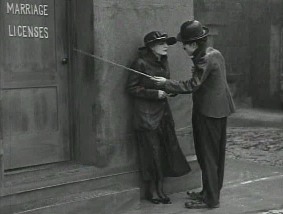The Immigrant

One of the many things that bothered me about James Cameron’s overblown romantic epic Titanic (1997) was the way it patted itself on the back for its blatant commentary on America’s class system. Cameron seemed to have forgotten that there was a two-reeler comedy that did the same thing eight decades previous – Chaplin’s The Immigrant - and did it probably for what it cost to light one of Titanic’s chandeliers.
Indeed, it’s kind of surprising that Chaplin stirred criticism where he thought to mix comedy and drama in The Kid four years later, seeing as he’d already done it so skillfully in The Immigrant. This is the perfect Chaplin combination platter: comedy, drama, pathos, symbolism, and yes, a smidgeon of social commentary – all delivered as smoothly and charmingly as you could hope for.
Chaplin plays the title role, a foreigner sailing for America on a rickety ship. Our first view of Charlie is his backside, as he hangs over the edge of the deck, seeming to relieve himself of nausea – only to turn around all smiles, showing off his prize catch of a fresh fish. (Contrast this with Chaplin’s later, far less imaginative A Day’s Pleasure, where he really does try to milk seasickness for ever-diminishing comedy.)
Eventually, Charlie meets up with a female immigrant (Edna Purviance) and her widowed mother. He befriends them and eventually gives them some money he won from gambling on the ship. Then comes the movie’s most famous shot. A title tells us the ship has reached “the Land of Liberty,” followed by a long shot of the Statue of Liberty, followed by Charlie and his shipmates being roped off like cattle before they can be let off the ship. (At least Charlie gets off a good kick to the guy doing the roping.)
The movie’s second half shows Charlie finding a coin on the street and using it to dine at a cheap restaurant. There, he reunites with Edna. In a perfect economy of action, Charlie (and we) see Edna alone and in black and immediately deduce that her sickly mother has passed on. Charlie expresses his sorrow and then tries to make the best of things, offering to buy dinner for Edna.
Then Charlie and Edna see a customer get batted about by the restaurant’s burly waiter (Eric Campbell) because he lacked a dime on his dinner bill. We’ve already seen the waiter get assertive with Charlie because he couldn’t take a hint to remove his hat in the restaurant. (Eric and Charlie’s hat routine will strike a chord with any Laurel & Hardy buff. In fact, much of this second half’s premise seems to have been bodily lifted for later use in the L&H short Below Zero [1930].)
Trying to assure himself, Charlie reaches into his pocket…and reaches…and reaches…and realizes the coin has fallen out. Chaplin manages to milk a good deal of business out of Charlie trying to avoid the waiter’s suspicious glare and to figure out how he will pay the bill.
As luck would have it, a nearby customer (Chaplin veteran Henry Bergman) is an artist who finds Edna and Charlie worthy subjects for his next painting. He confirms a deal with them and gives Charlie a couple of dollars in advance. In what is easily one of Chaplin’s most satisfying endings (emotionally and story-wise), Charlie drags coy Edna into the office of a local justice of the peace, to use the money to buy a marriage license for them.
The Immigrant is even more astonishing once you view the first segment of the astounding documentary Unknown Chaplin, which details the origins of many of Chaplin’s Mutual comedies. The Immigrant began as Chaplin’s vague idea of a comedy of manners, but it wandered aimlessly until Chaplin connected the dots and included the immigration concept. I wonder if Titanic began that modestly.
Click here to return to:
HomepageFilmography